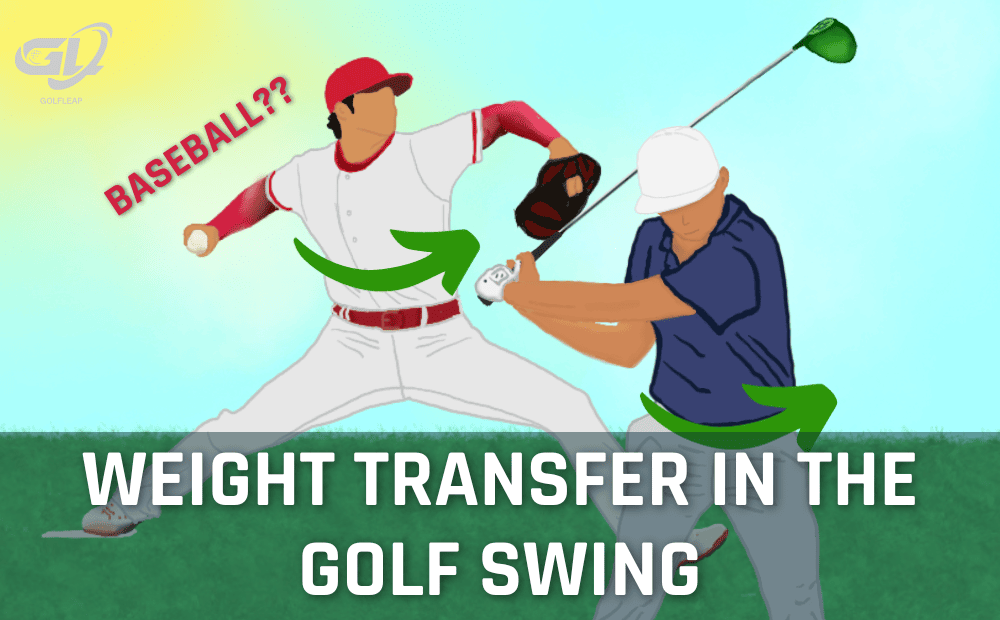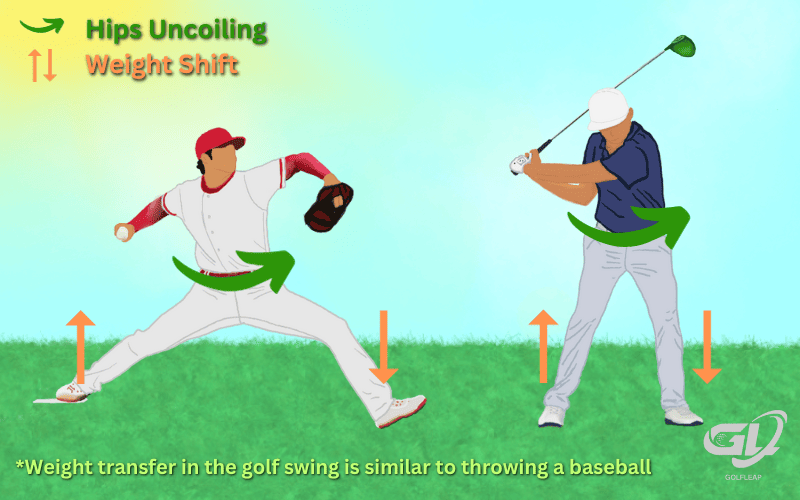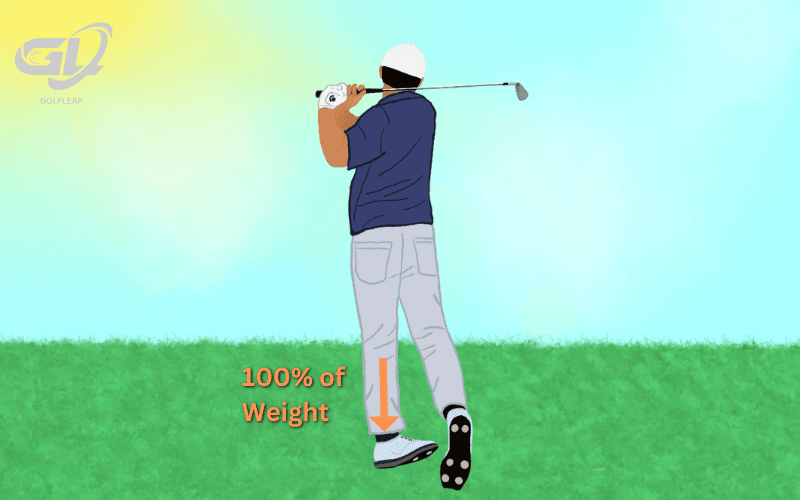
While no two swings will be exactly the same, the most accurate, consistent, and powerful golf swings perform a solid weight transfer (or “weight shift”) while occurring.
More commonly discussed elements of the golf swing like a proper stance, solid alignment, and the club face positioning during the swing are all influenced by your ability to transfer your weight efficiently.
Our breakdown will explain what the golf swing “weight transfer” is, our favorite ways to train a perfect weight transfer, and the swing problems you should expect from poor weight shift!
Table of Contents
What is the “Weight Transfer” During the Golf Swing?
“Weight transfer” or “weight shift” during your golf swing describes the feeling of your weight transferring from one foot to the other while your swing is happening.
We’ll discuss the weight transfer in percentages when describing your amount of body weight on each foot:
- At set up, you’ll generally want 50% of your weight on each foot. (Wedges can afford more weight on your leading side at setup since wedge swings are more compact/precise and require less weight transfer for ample distance.)
- As you begin your backswing, your weight should shift to your back foot (65%-75%).
- At the top of your backswing, your weight should begin reshifting to your front foot, and fully finish there through impact (80% Front – 20% Rear). This is also known as the hip bump in the golf swing!
What Makes the Golf Swing Weight Transfer Crucial?
Transferring your body weight toward your back foot during the backswing and toward your front foot through impact helps you maximize your potential golf swing power and distance.

A helpful demonstration our golf coach taught us when learning about the golf swing’s weight transfer is comparing it to a pitcher throwing a baseball.
To maximize their potential throwing power, a pitcher has a “wind-up,” followed by a lunge forward to their front foot, and then their throw.
- Compare the pitcher’s “wind-up” to the golf swing’s weight shift to the back foot.
- When the pitcher lunges forward before throwing, that’s a similar move to golfers shifting our weight to our front foot during the downswing.
- Finally, the pitcher releasing the ball towards the catcher (with all their weight on their front foot) is a similar finish to when the golfer makes impact.
Weight Transfer in the Golf Swing Explained: Step-by-Step
Transferring your weight properly in your swing can be broken down into 3 separate steps:
- Set-Up / Address Weight Position
- Backswing Transition
- Impact / Follow-Through Transition
Set-Up / Address Position
As we discussed earlier, most of your golf swings will begin with 50% of your weight on your back foot and 50% of your weight on your front foot.
Once beginning your backswing, your weight should begin to shift more toward your back foot from the 50/50 split starting position.
Since your hands, arms, and golf club will begin moving toward your backside during the backswing, your weight should naturally want to shift backwards to your trailing foot.
The “weight transfer” often gets confused with swing flaws like “swaying off the golf ball” or sliding your body away from your target during the backswing, which are vastly different topics from our ideal “weight transfer.”
While your body weight should shift backwards and then forwards, your actual body shouldn’t sway or slide away from your target.
Backswing Transition
I personally feel the most weight on my trailing foot during my backswing. (Roughly 65-70%)
As the club reaches its ending position in the backswing, I begin shifting my weight onto my front foot.
The transition from the backswing to the downswing is where most amateur golfers mess up, by keeping too much weight on their back foot or shifting too much weight to their front foot.
When the leading arm (left for right-handers) reaches parallel to the ground in the downswing, your weight should be back to 50/50 on each foot.
Impact / Follow-Through Transition

The best ball-strikers in the world transfer their weight to their front foot in a smooth and continuous motion, arriving at impact with 80% of their weight favoring their front foot.
During the follow-through and while waiting for the ball to reach its target, I personally feel almost all my weight on my front foot.
This feeling is what helps me achieve a balanced swing and photogenic follow-through with a pointed trailing foot!
2 Drills for a PERFECT Golf Swing Weight Transfer
Since the weight transfer is difficult to see and more focused on “timing,” we’d like to pass along two of our favorite drills that help any golfer feel what the swing’s weight transfer should be.
Golf Ball Under Heel Drill
If you’re a player experiencing slices and weak fades due to keeping too much weight on your back foot, try placing a golf ball under your trailing heel (right foot for righties).
- Take your normal golf stance and set-up position.
- Place a golf ball under your trailing heel.
- Complete your swing as normal.
This drill not only encourages you to stay centered while transferring your weight, but also keeps your club working on its intended swing plane and encourages you to shift your weight forward through impact (as it hurts your heel to stay on your back foot!)
Weighted Throwing Drill
A moderately weighted medicine ball works the best for this drill, but any free-weight, dumbbell, or decently heavy object will work.
- Take your normal golf stance holding the weighted item in both hands.
- Begin your backswing and focus on feeling your weight shift to your trailing foot.
- Complete your swing, and at “impact” throw the item as far forward toward your target as possible.
This drill helps emphasize the feeling of the proper weight transfer through the item’s added weight!
Swing Problems to Expect from a Poor Weight Transfer
A correct weight transfer helps ensure your clubface reaches impact at the proper position for ample distance and golf shots that go toward your target.
Here’s what happens with weight transfer flaws:
Swaying (Hooks or Slices)

When beginners hear the term “weight transfer” they often confuse it with “swaying” or shifting their body away from the target on the backswing and toward the target on the downswing.
This common flaw leaves the impact position up to “lucky timing,” causing hooks for some golfers and slices for others.
While your body weight should shift from 50/50, to the majority on your trailing side, to the majority on your front foot, your body should not “sway” or “shift” away from a centered position.
No Weight Transfer (Weak “Arm Swing”)
Golfers with limited mobility or those that started playing later in life often struggle with the “Arms Only” swing.
This swing completely destroys power and makes it difficult not to slice (since your range of motion is so limited from no leg or hip rotation).
A golfer with an “Arms Only” swing should focus on our “Weighted Throwing Drill” we explained earlier to feel the weight shifting from foot-to-foot and to get the lower body more involved for greater power!
Summary of Golf Swing Weight Transfer
In golf, weight transfer is vital for accurate, consistent, and powerful swings. It involves shifting your body weight during the swing, from a balanced golf setup (50/50) to a majority on the trailing foot during the backswing, then transferring back to the front foot through impact (80/20), and eventually almost 100% to your front foot at the finish. Proper weight transfer maximizes swing power and control and introduces mobility to your golf swing so definitely take some time to get this right!

